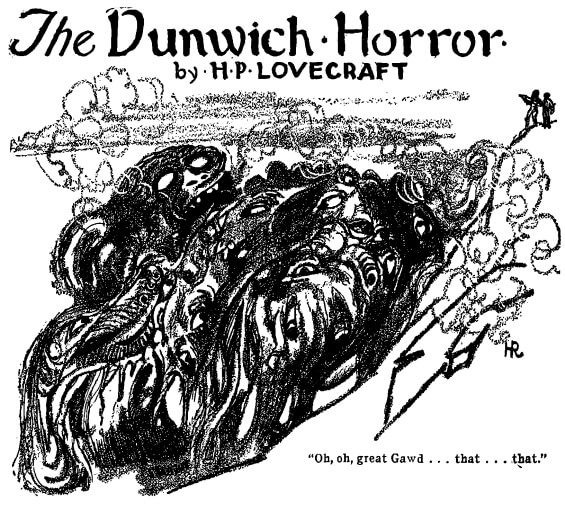 |
| Credit: Wikimedia Commons |
I’ve been watching an episode a week for the last three weeks of Guillermo Del Toro’s new Netflix horror anthology series, “Cabinet of Curiosities”. (Yes, you read that right; I only watch an episode a week and so I don’t do binge watching.) So far, the series has been really good. I first started watching the episodes in order (even though the series doesn’t have an over-arcing storyline), but only up to the second episode. That’s because I wanted to see how at least one of the two episodes based on H.P. Lovecraft stories played out. Episode five is based on the short story “Pickman’s Model”, and episode six is based on the short story “The Dreams in the Witch House”. I’ve only seen the first of these two so far and thought it mostly played out really good including the creature effects. However, an article at ScreenRant doesn’t seem to give it as much credit, nor does it give much more to episode six. The article’s author, Padraig Cotter, says the monsters are depicted in full too much. I can see where that can be a problem. It’s almost impossible to sufficiently depict Lovecraft’s monsters on screen because they’re indescribable in his stories.
Filming the Unfilmable in a 1970s B Movie
The monsters in many of Lovecraft’s stories are said by the narrator to be so horrifying in appearance that they can’t be described. We’re only given hints to what the monster looks like. These hints leave the monsters’ appearances to our imagination. Because of this, directors of Lovecraftian horror film and television have a lot of room to come up with some really terrifying monsters and a few have done a good job of it. Del Toro is one of them. However, he probably doesn’t capture the horror of Lovecraftian monsters as well as a 1970 big screen film does, as cheesy as it’s thought be by many. That movie is American International Pictures’ (AIP) version of Lovecraft’s novella, “The Dunwich Horror”.
AIP’s “Dunwich Horror” is the movie that I’ve, so far, seen come closest to depicting the indescribable horror of a Lovecraftian monster. It does this by showing the creature in such a way that the audience never gets a good look at it: it’s shown literally in flashes, as in strobe lighting. Similar to how characters go insane simply by seeing this monster, certain photosensitive people can go into a seizure by seeing it on the screen.
Psychedelic Monster
The reason this monster is portrayed in near-genuine Lovecraftian horror is because of the movie’s timing. It was made in that transitional period of the late ‘60s and early ‘70s, the era of psychedelic drugs. Many of these drugs gave their users ecstatic or uplifting sensations—psychedelic trips. But there were also some that gave bad trips. Users who experienced the bad sensations would go insane, some never recovering.
Like the uplifting trips, the bad trips influenced art in many mediums, including film. So, this nightmarish psychedelic influence on the creation of the monster in AIP’s “Dunwich Horror” is what made it so close to being indescribable like in Lovecraft’s novella. It made the unfilmable filmable.
As much as Del Toro depicts the horror in his Lovecraftian monsters, they are not as indescribable as the creature in AIP’s “Dunwich Horror”. One of the major elements of Lovecraft’s horror stories is the total unfamiliarity of the monsters. Because they are not fully described, they are hard to depict accurately on screen. But director Daniel Haller has done this best with this movie. It’s because of the impact of psychedelic culture of the time that the indescribable, and so what has often been the unfilmable, was filmable.
Author's Newsletter
The newsletter, "Night Creatures' Call", for November will probably not be coming out until early next month. I'm going to be too busy with family in the upcoming week for the Thanksgiving holiday. I'll announce the release of the newsletter as soon as it goes out. In issues of "Night Creatures' Call" I go over the progress and behind-the-scenes of my latest fiction; I also offer exclusive discounts on books and cover other sci fi/fantasy news, info and details on events, such as the Smashwords book sale, not covered here at A Far Out Fantastic Site. If you haven’t done so yet, sign up for a free subscription!
What movie adaptation of a Lovecraft story do you think depicts the monster best?
For those of you in the US, have a Happy Thanksgiving!
Until next time . . .
Ironically, I also watched the first two episodes and then skipped to Pickman's Model!
ReplyDeleteIt's been years since I saw The Dunwich Horror. I'd have to go back and see it again to really remember it.
I thought the creatures in The Resurrected, based on The Case of Charles Dexter Ward, were quite effective and creepy.
The Resurrected, I think I've heard of it but never seen nor even knew it was based on an H.P. Lovecraft story. I'll have to check that one out.
Delete